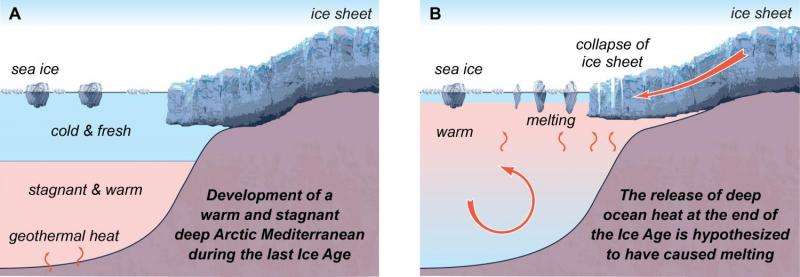A study, just published in the journal Science (August, 2015) has been looking at the circulation of water in the Arctic Ocean and Nordic seas – and how it compares between today and the last Ice Age. See http://phys.org/print358682877.html
The cold Arctic winters of the modern world produces cold dense surface water that sinks to the bottom (or that is the theory) and flushes out the warmer bottom waters. The research found that during the Late Glacial Maximum, when ice sheets covered large areas of Scandinavia and Scotland, the Arctic became a large stagnant pond – and deep waters were not being replenished (or flushed out). One can see that models may arrive at such a conclusion, based on the assumption an ice sheet covered most of the northern hemisphere, and the idea is not unreasonable when we take into account Beringia blocked the Asian side of the ocean (creating a very large pond). The theory here is that the ice sheet blocked the ability of the atmosphere to cool the waters beneath the ice – although you would have thought the ice itself was enough to make the water very cold. One thing the modelling probably did not include and that is the fact that most of Siberia and some bits of N America were warm enough to harbour enough plant life to sustain great herds of of animals (herbivores).
The water (under the ice) was not only stagnant, but warm (or relatively so) as the bottom waters were subject to geothermal heat rising out of the sea floor. At a critical stage the ocean became unstable – and the heat caused the ice above to melt – and hey presto, a retreating ice sheet.

Apparently there is evidence of a massive release of melt water into the Nordic Sea (they've been keeping that quiet). The hypothesis is that the heat below the ice caused the ice sheet to melt – rapidly if there was a massive release. The problem here is that the ice around the North Pole was for some reason able to resist the inclination to melt – unless there is also evidence that the present locality of the North Pole was not as thickly covered in ice as it is at the moment. Of course, if the position of the North Pole has changed since the Late Glacial Maximum, an even more abrupt and dramatic change to the geographical spread of the ice sheet would have occurred – but that was not part of the model input.
The study does highlight the role of ocean circulation – which nowadays is capable of filling the Arctic Ocean with enough warm water to reduce summer sea ice levels as a result of El Ninos in the tropical Pacific shifting warm water towards the poles – where excess heat is dissipated into the atmosphere. The late 20th century witnessed a surfeit of El Ninos (and a reduced number of La Nina cooling events) which led to summer sea ice levels becoming an alarmist tune for a number of years. Now the sea ice is reforming as a result of a surfeit of La Ninas (and a reduced number of El Ninos) they are not so fond of mentioning the fact sea ice levels in the Arctic have increased – and will keep on increasing over the next decade or so.
All in all, a very clever paper with the obligatory hand wave towards CAGW. The study involved work in the field (and in the laboratory) – such as taking sediment cores in order to analyse plantonic shells (foraminifera) to ascertain oxygen isotope changes – and the switch from cold to warm water varieties of plankton. It is always difficult to comment on an abstract without reading the full paper – and I shall have to try and get hold of the full article. There is some intriguing references in the paper.
